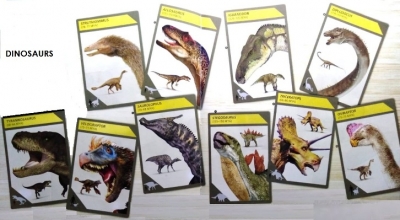
DINOSAURS
Long ago, life on Earth was dominated by the dinosaurs, a group of reptiles that included huge, lumbering plant-eaters and fearsome, agile hunters. Except for the birds, dinosaurs became extinct 66 million years ago (MYA), but their fossilized remains survive in the rocks of ancient continents, allowing scientists to reconstruct what they looked like and how they lived.
- STRUTHIOMIMUS
Standing taller than a man, this agile, fast-running dinosaur was more like an ostrich than a typical reptile. It had no teeth in its long jaws but had a beak made from keratin, like birds. It was probably a herbivore.
- ALLOSAURUS
Although it probably looked very like Tyrannosaurus, the fossils of this massive meat-eater have been found in rocks that are at least 70 million years older. This timespan is longer than the period that separates the last dinosaurs from our own time.
- TYRANNOSAURUS
The biggest of the tyrannosaurs, Tyrannosaurus rex grew to 12 m (39 ft) and had thick, banana-shaped teeth up to 15 cm (6 in) long. Its fossilized remains have been found in rocks in North America, notably in Montana and South Dakota.
- VELOCIRAPTOR
Found in Mongolia, the fossil bones of this smallish dinosaur are similar to those of the first birds, and recent research shows that it may have had feathers. It was an agile, high-speed hunter that probably jumped on its prey and gripped with its hooked claws.
- SAUROLOPHUS
This plant-eater had a bony crest on its skull that may have supported an ornamental crest. Fossils from Asia have longer crests than fossils found in America, showing that there were at least two different species.
- IGUANODON
Iguanodon was a large, bulky herbivore with a strange spike on its thumb. Scientists are still unsure how this spike was used.
- STEGOSAURUS
Stegosaurus fed on plants in what is now North America and Europe, 155–150 million years ago. Scientists still puzzle over the function of the huge bony plates on its back, which are not attached to the backbone. Two pairs of spikes on the tail were likely to be used to ward off predators.
- TRICERATOPS
The bony neck shield and three sharp horns of Triceratops were used in combat with other Triceratops. Judging from fossilized bones found in North America, the animal grew to at least 9 m (30 ft) long.
- DIPLODOCUS
This giant dinosaur lived in what is now North America at the same time as Allosaurus, but used its long neck to browse over a large area. It was up to 27 m (89 ft) long, with a small head and whip-like tail.
- OVIRAPTOR
Similar to the larger Struthiomimus, this bird-like dinosaur had short powerful jaws and possibly a beak. It was earlier thought to have been an “egg-thief” because the first fossil specimen was found on a nest of dinosaur eggs, and scientists believed that it may have died trying to steal them. However, further research suggests it is likely that the Oviraptor was just incubating its own nest, not stealing the eggs.
Picture Credit : Google



